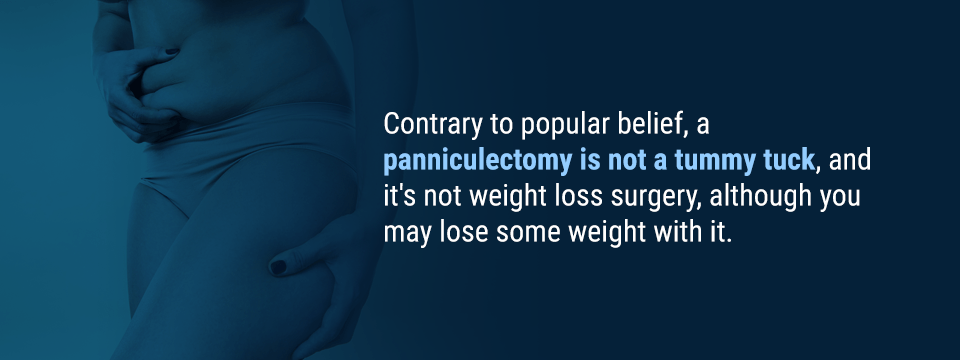If you have skin and fat extending to your knees, you are more likely a candidate for a panniculectomy. If you have excess skin and fat hanging from your lower abdomen and the excess partially or totally covers the pubic region, you are more likely a good candidate for an abdominoplast. If you are unable to determine or are unsure which procedure to undergo, if you have rashes, ulcers, or any skin disorders on the hanging skin, a panniculectomy or tummy tuck may need to be performed.
The most common problems that may lead to insurance approval for a panniculectomy are skin irritation or skin erosion under the pannus and interference with typical daily activities. A tummy tuck, which is also known as an abdominoplasty, is a cosmetic procedure designed primarily to improve the appearance of the torso. It often also involves tightening of the abdominal muscles that are typically stretched out during pregnancy. Since a tummy tuck is a cosmetic procedure, it is not covered by insurance.
Re: panniculectomy vs tummy tuck.. Are you planning on having more children in the future? A panniculectomy is strictly removing the skin flap that tends to hang. It will do nothing to the actual "stomach" area. You will have the same scar either way, but if you're planning on more children, most doctors would probably advise to wait on the tummy tuck b/c it would be a waste of time and money. The risks are the same for both surgeries.
This Beverly Hills surgery cannot erase the stretch marks though it may slightly improve it. Do note that it may leave a scar in the case of chronic weight loss when surgery is done. The excess fat which is below the belt line sags and is known as pannus or abdominal apron and can severely give a negative effect on the quality of life.
Initially, it may be uncomfortable after the surgery but the side effects come down with proper post-surgery care through medication. For a few weeks, no hard or heavy work should be done. The stitches will be removed in about weeks’ time. In due course of time, the stitch marks will also fade away.
Something to keep in mind, while a panniculectomy may be covered for by insurance, a panniculectomy does not provide the best aesthetic or best look for the abdomem. The panniculectomy also does not tighten the abdominal muscles. The purpose of a panniculectomy is to remove the pannus (hanging skin) and potentially alleviate low back pain or discomfort you may have. For a tummy tuck, usually the incision is made horizontally on the lower abdomen. The abdominal muscles (rectus abdominis) is tightened.
It’s important to be able to rest, as well as get in a few short walks. You do not want to be running errands or spending time searching for things you need for your recovery. Sometimes it’s difficult to figure out which surgery will give you the results you’re looking for. If you think a panniculectomy may be a good choice for you, give us a call. Our expert, compassionate surgeons can help you understand the difference between a panniculectomy vs tummy tuck, and which is the best choice for your goals.
They are not. A tummy tuck is more of a cosmetic, aesthetic plastic surgery procedure whereas a panniculectomy is more of a reconstructive and medically necessary plastic surgery procedure. To know which procedure is best for you, and to know which type of candidate you are, here is what you need to know. Patients who have fat and skin extending below their knees, over their hips, pubic region, and around the back. If you have rashes, ulcers, or skin conditions, you also be a good candidate for a panniculectomy.

